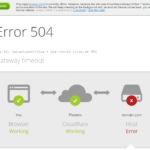If you’ve ever encountered a “Gateway Timeout” message while browsing the internet, you’ve come across an HTTP 504 Error. But what exactly does it mean, and why is it important to understand it? Let’s break it down.
Understanding HTTP Status Codes
The Basics of HTTP Status Codes
HTTP status codes are standard response codes given by web servers on the internet. They help identify the status of the requested resource. When you visit a webpage, your browser sends a request to a server, and the server responds with a status code indicating whether the request was successful, redirected, encountered an error, or something else.
Categories of HTTP Status Codes
HTTP status codes are grouped into five categories:
- 1xx: Informational responses
- 2xx: Successful responses
- 3xx: Redirection messages
- 4xx: Client error responses
- 5xx: Server error responses
The 5xx Series: Server Error Responses
Overview of the 5xx Status Codes
The 5xx series represents server error responses, indicating that the server failed to fulfill a valid request. Common 5xx errors include:
- 500 Internal Server Error: A generic error message for unexpected server issues.
- 502 Bad Gateway: Indicates that the server received an invalid response from an inbound server.
- 503 Service Unavailable: The server is not ready to handle the request, often due to being overloaded or down for maintenance.
- 504 Gateway Timeout: Occurs when a server acting as a gateway or proxy does not receive a timely response from an upstream server.
Diving Deep into HTTP 504 Error
Definition of HTTP 504 Error
An HTTP 504 Error, also known as a Gateway Timeout error, indicates that a server did not receive a timely response from another server it was accessing while attempting to load a webpage or fulfill another request.
How HTTP 504 Error Differs from Other 5xx Errors
While similar to other 5xx errors, the 504 error specifically points to a timeout issue between servers, often involving gateways or proxies. Unlike a 502 Bad Gateway error, which is typically due to an invalid response from the upstream server, a 504 error means that the upstream server didn’t respond in time.
Causes of HTTP 504 Error
Server Overload
When a server is overwhelmed with traffic or resource demands, it might not be able to respond to all requests in a timely manner, leading to a 504 error.
Network Issues
Problems with the network infrastructure, such as slow connections or interruptions, can prevent timely communication between servers.
DNS Problems
If the Domain Name System (DNS) is not configured correctly or is experiencing issues, it can lead to delays in routing requests to the correct server, causing timeouts.
Firewall and Security Software
Sometimes, overly strict firewall or security software settings can block communication between servers, resulting in a timeout.
Server Misconfigurations
Incorrect settings on either the server handling the request or the upstream server can cause delays and timeouts.
How to Identify an HTTP 504 Error
Symptoms of an HTTP 504 Error
Common signs of an HTTP 504 error include:
- Long loading times followed by a “Gateway Timeout” message.
- Inability to access specific websites or pages.
- Consistent errors across different browsers or devices.
Tools and Methods to Diagnose HTTP 504 Errors
To diagnose an HTTP 504 error, you can use tools like:
- Ping and Traceroute: To check network paths and latencies.
- Browser Developer Tools: For detailed error messages and logs.
- Server Logs: To identify timeout events and possible causes.
- Online Services: Such as DownDetector to see if the issue is widespread.
Impact of HTTP 504 Error on Websites
User Experience
Frequent 504 errors can frustrate users, leading them to leave your site and possibly never return. User experience is crucial for retaining visitors and encouraging engagement.
SEO and Website Rankings
Search engines like Google consider the reliability and uptime of websites. Frequent 504 errors can negatively impact your SEO rankings, as search engines might view your site as unreliable.
Revenue and Conversion Rates
For e-commerce and service-based websites, 504 errors can lead to significant revenue loss. If users can’t access your site or complete transactions, you lose potential sales and conversions.
Preventing HTTP 504 Errors
Regular Server Maintenance
Ensure that your servers are regularly maintained and updated to handle the expected traffic and load.
Optimizing Server Performance
Use caching strategies, optimize database queries, and manage resources efficiently to prevent server overload.
Enhancing Network Stability
Invest in reliable network infrastructure and consider using multiple ISPs to prevent network issues from affecting server communication.
Monitoring DNS Configurations
Regularly check and update DNS settings to ensure they are correct and optimized for performance.
Troubleshooting HTTP 504 Errors
Initial Checks and Quick Fixes
Start by checking your server’s status, rebooting your network equipment, and verifying DNS settings. Sometimes, simple actions like these can resolve the issue.
Detailed Troubleshooting Steps
If initial checks don’t help, delve deeper:
- Review server logs for errors or unusual activity.
- Check network connections and firewall settings.
- Test different configurations to isolate the issue.
When to Seek Professional Help
If the problem persists and you can’t identify the cause, it might be time to consult with IT professionals or your hosting provider for advanced troubleshooting.
HTTP 504 Error and Web Hosting Providers
Role of Web Hosting Providers
Your hosting provider plays a significant role in your site’s performance. They are responsible for maintaining the servers and network infrastructure that support your site.
Communicating with Your Hosting Provider
If you encounter persistent 504 errors, contact your hosting provider. Provide detailed information about the issue, including error logs and any troubleshooting steps you’ve already taken.
Choosing the Right Hosting Plan
Ensure your hosting plan can handle your website’s traffic and resource needs. Sometimes, upgrading to a more robust plan can resolve persistent timeout issues.
Case Studies: Real-World Examples of HTTP 504 Errors
Example 1: High-Traffic E-commerce Site
A high-traffic e-commerce site faced 504 errors during peak shopping seasons. By optimizing server configurations and implementing load balancing, they significantly reduced these errors.
Example 2: Content-Heavy Blog
A content-heavy blog experienced frequent 504 errors due to server overload. Switching to a more powerful hosting plan and optimizing database queries helped resolve the issue.
Example 3: SaaS Platform
A SaaS platform encountered 504 errors due to network issues. By enhancing their network infrastructure and implementing failover mechanisms, they improved stability and reduced downtime.
HTTP 504 Error and Content Delivery Networks (CDNs)
How CDNs Work
CDNs distribute content across multiple servers worldwide to reduce load times and improve performance.
CDNs and HTTP 504 Errors
CDNs can sometimes be the cause of 504 errors if there are issues with the network or configurations.
Optimizing CDN Configurations
Ensure your CDN settings are optimized for your site’s needs and regularly monitor performance to catch and resolve issues promptly.
Best Practices for Web Developers
Writing Efficient Code
Efficient code reduces server load and improves response times, helping prevent timeouts.
Using Asynchronous Requests
Asynchronous requests allow other processes to continue running while waiting for a response, improving overall performance.
Handling Server Timeouts Gracefully
Implement error handling in your code to provide users with meaningful messages and options when a timeout occurs.
The Future of HTTP Error Handling
Advances in Server Technology
New server technologies and architectures are continually being developed to handle increased loads and reduce errors.
AI and Automated Error Resolution
AI can help predict and automatically resolve issues before they cause significant problems, reducing the occurrence of errors like 504.
Trends in Network Infrastructure
Advancements in network technology, such as 5G and improved routing protocols, will enhance stability and performance, reducing errors.
Conclusion
HTTP 504 errors can be a headache, but understanding their causes and impacts, as well as implementing preventive measures and effective troubleshooting, can keep your website running smoothly. Regular maintenance, optimization, and staying updated with the latest technology trends are key to avoiding these issues.
















Leave a Review